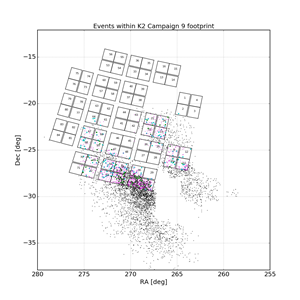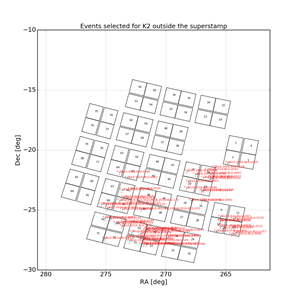ExoFOP-K2 Campaign 9 Contributed Data
The Kepler Primary Mission ended in 2013 when two of the observatory's four reaction wheels ceased to function. The Kepler Mission was reborn as the K2 Mission, which ran for an additional five years.
K2 Campaign 9 (K2C9) was executed April 7 to July 1, 2016 to study gravitational microlensing events. The Campaign 9 microlensing experiment involved the Kepler spacecraft observing in the +VV direction at fields toward the Galactic bulge. The program's aim was to simultaneously observe gravitational microlensing events with K2 and from Earth with ground-based telescopes in order to see a parallax effect in the shape and time of the lensing event.
As K2C9 was not driven by pre-identified targets, the Exoplanet Follow-up Observing Program's (ExoFOP) support for the microlensing campaign was specifically tailored. The general strategy was designed in discussions with the Microlensing Science Team. The three main components were:
- A list of all identified events in the K2 field
- A collection of detailed information on each event
- A graphical display of available telescope resources
The ExoFOP-K2 C9 Data Set
The event list was driven by events collected by the Las Cumbres Observatory Global Telescope Network's RoboNet, which collected events and photometry from ground-based microlensing projects. The detailed information for each event included photometry, images and modeling results. In addition, users uploaded data, model parameters, and files through the ExoFOP-K2 C9 website, which was decommissioned in 2022.
Event Selection Criteria
A targets was included in ExoFOP-K2C9 if:
- It was located within the K2C9 overall footprint, whether or not it lies in the superstamp region.
- (t0 - 2tE) < campaign_end and (t0 + 2tE) > campaign_start
Download the Data
The ExoFOP-K2C9 data and documentation can downloaded from the following links:
- K2C9 Data Archive (.tar.gz) (570 MB)
- K2C9 README (.txt)
ExoFOP-K2 C9 Event Maps
Click the images to view a larger version:
Additional Resources
- Exoplanet Follow-up Observing Program
- The Open K2 Initiative: A GitHub repository containing K2 code, candidates, and resources.
- NASA Kepler and K2 Page
- MAST K2 Archive
Last updated: 11 May 2022






